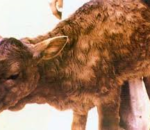Arthritis
It is an inflammation of tissues associated with joint caused by bacterial, fungal, or viral infections, (either primary or secondary to trauma at joint), and characterized clinically by the signs of lameness, local pain at palpation, and apparent swelling at the joint(s) involved.
Primary Arthritis
Hematogenic spread of infectious agents arising from generalized septicaemia or localized suppurative process elsewhere in the body, reach the joint(s). Arthritis may develop secondary to mastitis, metritis, endocarditis, suppurative pneumonia, pyelonephritis, and other septicemic conditions. Arthritis may also develops from extension of infections from local skin lesions.
Arthritis may also develop as an associated lesion of some specific diseases, including tick pyemia of lambs, tuberculosis, strangles, mycoplasma infections, serositis arthritis in sheep and goats, caprine arthritis, encephalitis virus infection, brucellosis, bovine viral diarrhea, and ephemeral fever.
Secondary Arthritis
This type of arthritis occurs due to trauma, sporadic cases of this arthritis may be seen due to joint capsule trauma, causing initially acute sero-arthritis, which later may develops into suppurative arthritis (if followed by secondary bacterial infection).
Clinical Findings:
Clinical signs vary and depend upon the number of the joints and their sites.
1. If leg joints are involved, there will be severe lameness, inability to stand, or continue lifting of the leg. Signs of inflammation can be detected on palpation of joints.
2. Sometimes, rupture of joint capsule leading to escape of pus to exterior can also occur.
3. When multiple joints are affected, signs of toxaemia and septicemia may also be observed. These signs can also lead to death due to complications such as broncho-pneumonia or endocarditis.
4. In chronic arthritis, there may be fibrosis, thickening of the joint capsule, ankyloses, and ossification. Crepitus can be felt during walking because of erosion or chip fracture at the articular surface.
Myositis
It is an inflammation of muscles which may be caused by either physical trauma or some specific diseases involving muscles. Acute myositis is characterized by severe lameness, swelling, and signs of toxaemia. In chronic finding, only muscle wasting is the major finding.
the specific diseases causing myositis are as under
Bacterial diseases: Black leg (Black quarter), Malignant edema, actinobacillosis and tetanus.
Viral diseases: Foot and mouth disease (FMD), bluetongue, bovine viral diarrhea, ephemeral fever, and equine influenza.
Parasitic infestation: Larvae of certain parasites e.g., Toxoplasma gondi, taenia solium or taenia saginata and Cysticercosis, if present in the muscle of animals, may cause myositis.
Fungal Diseases: Blastomycosis, coccidiomycosis, and nocardiosis, can be associated with myositis.
Physical causes: Trauma to muscles caused by wither kick, blow bite, road accident, sprain, or fire arm injuries are common causes of myositis.
Miscellaneous causes: Atrophic myositis, Myositis ossification (inherited condition), Chemical myositis due to IM injection of any irritant drug, and neoplasia of muscles are some examples.
Clinical Findings:
1. Signs of inflammation are visible i.e., Swelling, heat, pain, loss of function.
2. If leg muscles are involved, there will be lameness, stiff gait, difficulty in sitting, and standing or persistent recumbency.
3. If neck muscles are involved, the neck may be turned to one side and there will be difficulty in grazing.
4. Signs of toxaemia and systemic reaction may also be found in acute cases.
5. Urine colour is also changed from red to chocolate due to the presence of myoglobin.


